|
Collecting American Belleek
By Loman and Petula Eng
American art ceramics made in the late 1800s to early 1900s represent a very
important part of our nation's art history. There is a misconception that art
ceramics made by Americans in the 19th century and early 20th century are
inferior to those made overseas. If you take a Ceramic Art Company (formerly the
Lenox Company) porcelain vase, hand painted with roses by William Morley, and
compare it with any porcelain vase made in Europe, it is just as good, if not
better. We have no intention of discouraging collecting foreign porcelain since
everyone has his or her own interests. We only want to bring to the attention of
collectors that there is something really good at home waiting for them to
discover and collect as well. We consider these fine porcelains made here as
national treasures worth collecting and displaying.
American Belleek
porcelain, as it is called, is generally referred to as fine porcelains made
from the 1880s to the early 1930s in Trenton, New Jersey, although its history
goes back to as early as 1852 when the McCully Family operated in that area with
one kiln. During those 50 years, the area around Trenton was the only major
porcelain industry in America, although it also produced pottery.
Of course,
there are other areas producing pottery such as Zanesville, Ohio, where
Roseville and Weller were operating, but no other places produced as much fine
porcelains as in Trenton. By 1920, a total of 48 potteries operated in the area
with an astounding output of $30 million. It was not an exaggeration when the
Trenton Times once said that in the early 1920s, when the industry was still
flourishing; as many as 7,000 cheesecakes were sold daily to Trenton's pottery
workers during the lunch hour. However, the industry began to decline as early
as 1927.
The 1930s saw the demise of Trenton's pottery industry as a whole.
There were several factors that led to the end of this industry in America. The
strikes by potters in Trenton in 1894 and 1895 had a long-lasting effect on
production efficiency and costs, which directly affected its competitiveness
against imports. The potters faced not only fierce competition from abroad but
also amongst themselves. World War I reduced the labor pool at home. The
resistance to new technology and the increasing use of plastics by consumers
were two other factors. Finally, the successful lawsuit by an Irish company
prohibiting American potters from using the name Belleek and the Great
Depression played important roles in the failure of the industry.
Today,
only one company from the American Belleek era has survived. It is
Lenox.
Although there were many potters producing porcelains in Trenton,
N.J., during that period, three of them had the most influence on the success of
the industry that contributed to the prosperity of the region and to the nation.
Ott & Brewer. In 1863, Joseph Ott, a native of Hunterdon County, N.J.,
formed a partnership with two friends, William Bloor and Thomas Booth, on the
outskirts of the city of Trenton under the name of Bloor, Ott and Booth. Booth
retired in 1864 and sold his share to Garrett Burroughs. A year later, Ott's
nephew, John Hart Brewer, bought Burroughs share and joined the partnership. The
name of the partnership was changed to Ott & Brewer after 1871, although the
exact date was not clear. When Bloor retired in 1871, John Brewer, who worked
alongside him for six years, took over the company's directorship.
In the
early years, decorated granite ware and cream-colored wares were main staples of
the company. In 1876, Ott & Brewer put out a ware known as "ivory
porcelain," which was regarded as the first entirely American made porcelain. It
resembled Irish Belleek in style but not in composition, and it was not as fine.
For years, the Trenton potters worked very hard to make fine porcelain that
could rival the Europeans. In 1892, Ott sought help from William Bromley, Sr.,
who had firsthand expertise in making Irish Belleek. Around late 1883 to early
1884, Ott & Brewer successfully made the first American Belleek, a fine
porcelain ware that resembled Irish Belleek, but was made entirely from American
materials with soil from the New Jersey clay beds and water from the Delaware
River. One of the early pieces was described as a square tray, supported by four
legs, white ground with a morning-glory design in blue and gold, and a scalloped
rim outlined in gold.
In ten years of Belleek production, Ott & Brewer
did not stop improving the quality of its wares. Many regard their porcelain as
the finest porcelain ever produced in the United States. Due to a decline in
demand for high quality products, Ott & Brewer was forced to suspend
production in 1892 and into a receiver's sale in 1893.
Ceramic Art Company and Lenox
Jonathan Coxon and Walter Lenox were
co-workers at Ott & Brewer during the height of its Belleek years. Lenox
later left the company to join Willets as head of the designing department
around 1885. In 1889, they formed a partnership, the Ceramic Art Company (CAC),
to realize their own vision of Belleek making. By 1897, the company's catalog
listed as many as 300 different items available for the public.
In 1896,
Coxon left the company. Walter Lenox continued to work tirelessly to expand its
business, although he was unfortunately stricken with a sickness in 1895 that
eventually left him blind and paralyzed. Around 1900, Lenox made two very
important decisions. One was to expand its product line to tableware, and the
other was to hire Frank Holmes as chief designer in 1905. Holmes was later
appointed to design three sets of White House China  those for Woodrow Wilson
in 1918, Franklin D. Roosevelt in 1934, and Harry S. Truman in 1951. In 1906,
the company's name was officially changed to Lenox. The company stopped
producing American Belleek in 1930s, but it continues to put out fine porcelain
today.
Willets Manufacturing Company
In 1879, three brothers, Joseph, Daniel and
Efmund R. Willets, bought out the Excelsior Pottery built by the William Young
and Sons Company. The company started with four kilns, and by 1882, it had
expanded to fourteen kilns and hired about 300 hands.
Around 1884, William
Bromely, Sr., after successfully helping Ott & Brewer make Belleek wares,
went to help Willets do the same. As a result, Willets began producing Belleek
wares around late 1884 or early 1885. During that period, they hired many
competent artists, including Walter Lenox, to design their wares. In less than
ten years since they first made their white eggshell wares, Willets' American
Belleek was compared favorably with industrial leaders in both America and
Europe. After the industry as a whole began to decline due to many factors,
Willets stopped its production in 1909, ending their 24 years of making American
Belleek.
* * *
* * * *
As the first porcelains ever made by American potters,
American Belleek was also the only major porcelains made from the late 1880s to
early 1900s in the United States. Thus, many collectors collect American Belleek
not only for their personal pleasure, but also for preserving our national
treasures. More are collecting American Belleek every year, and this trend is
getting stronger every day. Since our book was published four years ago and as
we have traveled around, we have found that it is more difficult to find
American Belleek in antiques shops and shows. Prices are going up, especially
for Ott & Brewer pieces and factory artist-decorated CAC/Lenox items (such
as those hand decorated plates by William Morley). We hope more collectors will
collect and display American Belleek at home and make American Belleek a
household name in the future.
Loman and Petula Eng, authors of
Collecting American Belleek (Schiffer Publishing, 2003), have been collecting
American Belleek since 1976. Loman is now a full time artist while Petula
manages a multi-dealers' shop in Rhinebeck, N.Y. They can be reached at 7 West
Market Street, Rhinebeck, NY 12572, 845-876-5555 or www.engsart.com
.
All
photos, courtesy of Loman and Petula Eng.
|
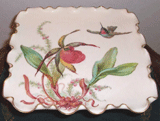
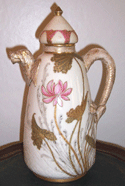
Ott & Brewer square
cake stand and an 11 1/2-inch chocolate pot.
Both are valued at $2,350 to $2,750.
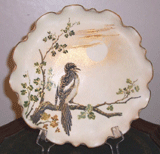
Ott & Brewer lunch plate,
8.75 inches, $900-$1,100.
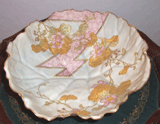
O & B egg-shell bowl, 8.75 inches, $1,750-$2,500.
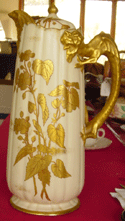
Willets pitcher, 9.75 inches, $1,350-$1,650.
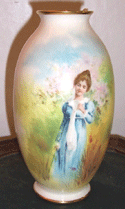
Ceramic Art Company portrait vase, 7.75 inches, $900-$1,200.
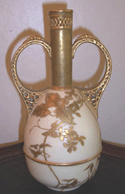
CAC vase, 9.25 inches,
$800-$1,000.
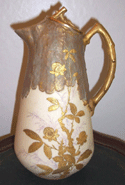
CAC coffeepot, 10.75
inches, $1,350-$1,750.
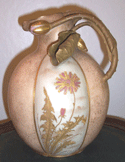
O & B pitcher, 9.5 inches, $2,500-$3,000. |